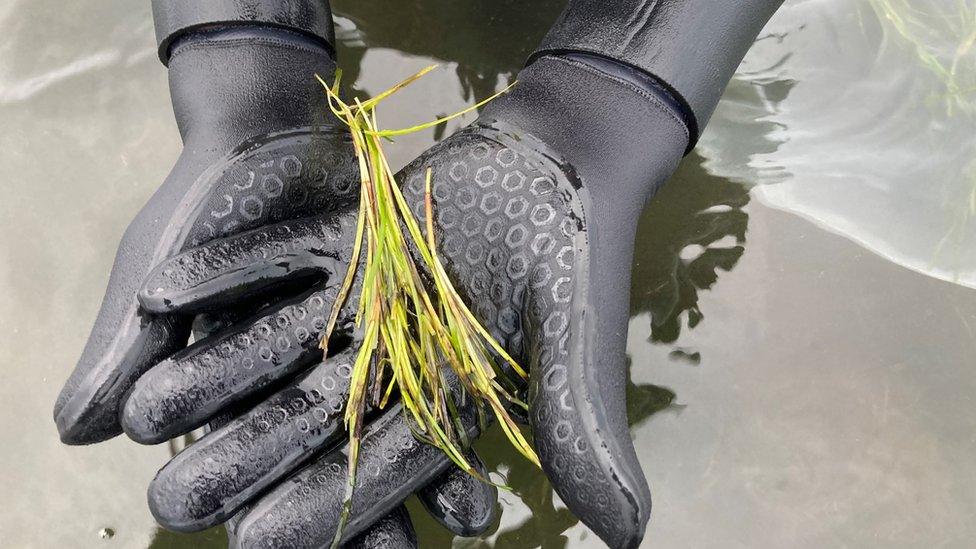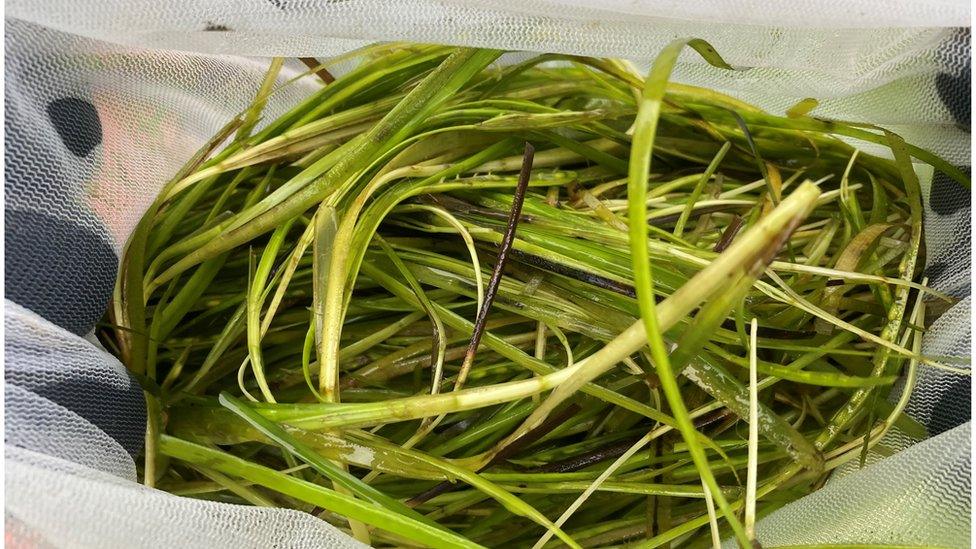Seagrass from Orkney regenerates Firth of Forth
- Published

Seagrass meadows ranging from just half a hectare to more than 50 hectares are found around Orkney's coastline
Beneath the sea off Orkney a team of divers is harvesting an unusual crop - but one they hope can help undo decades of environmental damage.
The islands' waters are home to the UK's most pristine seagrass meadows - swathes of flowering marine plants, with thick grass-like leaves.
A vital part of the marine ecosystem, they stabilise the seabed and help maintain water quality.
But in the last century 92% of them have been lost from Britain's coasts.

Lyle Boyle, seagrass officer with Restoration Forth, is one of a number of divers who have been collecting seagrass seeds in Orkney
The Firth of Forth is no exception. Thanks to decades of land reclamation and industrial use, the remaining seagrass meadows are under threat.
But now the important habitat is being regenerated with seeds harvested in Orkney.
Seeds planted in a pilot project are already germinating and are starting to provide a home for undersea species.
So now scientists are back to collect more.

The project say they only collect every third reproductive shoot they find, to minimise the impact on Orkney's seagrass beds
Lyle Boyle, seagrass officer with Restoration Forth, external told BBC Radio Orkney they'd picked a small seagrass meadow at Finstown - halfway between Kirkwall and Stromness - for their harvesting site.
He describes it as "like a marine equivalent of a savannah" with large green blades, providing fantastic habitats for marine wildlife.
In less than half an hour he had come across "small to medium sized starfish, green shore crabs, sea anemones, small pollock darting around amongst the blades, and literally as soon as we got in we did see a flatfish".

Marie Seraphim hopes regenerated seagrass beds in the Firth of Forth will one day be as rich in marine life as those in Orkney

There may be as many as 800 seagrass plants in every square metre of seabed
Marie Seraphim from the Scottish Seabird Centre in North Berwick hopes that regenerated seagrass meadows in the Firth of Forth will one day provide a home to that same rich range of underwater life.
At the moment, she says the area's seagrass meadows are in trouble.
"We do have some remaining, but very little," she explained.
"The idea is to kick-start a regenerative process, by starting a new population of seagrass plants.
"The meadows in Orkney and in the Firth of Forth are genetically very similar, So this is also why we come to Orkney, because we don't want to introduce seagrass from the west coast, where they are quite different genetically."

Esther Thomsen from Project Seagrass says taking the seeds won't have any noticeable impact on Orkney's seagrass beds

The harvested material has to be kept in seawater until it can be taken to the Firth of Forth and planted out there
Esther Thomsen, the Project Seagrass, external operations lead in Scotland, says taking the seeds won't have any noticeable impact on Orkney's seagrass beds.
"We have done some surveys", she says, "and there are up to eight hundred sea grass shoots per square metre of seabed".
Researchers say they harvest every third shoot they find that contains viable seeds, without disturbing the root, or other parts of the plant. Seed is only collected from healthy and dense seagrass beds which should minimise the impact.
And project manager for Restoration Forth, Naomi Arnold, says trials with seeds harvested from Orkney seagrass beds last year are already starting to show good results.

Naomi Arnold, project manager for Restoration Forth, says seeds taken from Orkney appear to be doing well in their new location
"The seed that we planted in March has germinated already and we have seen a baby flatfish already in that germinated seagrass, so we can see signs of life being able to be supported which currently is very low (in the Firth of Forth)."
There is a warning though that regenerating disappearing beds of seagrass won't be quick.
Esther Thomsen from Project Seagrass says: "You can think about it as planting a forest. So you start planting with a few small saplings and then after years of waiting you will have a nice big forest."
But Lyle Boyle says it should be worth it: "The Firth of Forth has been an improving environment over the decades, and we think now it's at a stage where it can undergo a restoration.
"We have actually seen germination success, So it's proving that it's a successful method, and there's hope at the end of the line that we can restore our meadows."
- Published29 June 2023

- Published8 June 2022

- Published7 June 2022

- Published13 March 2021
